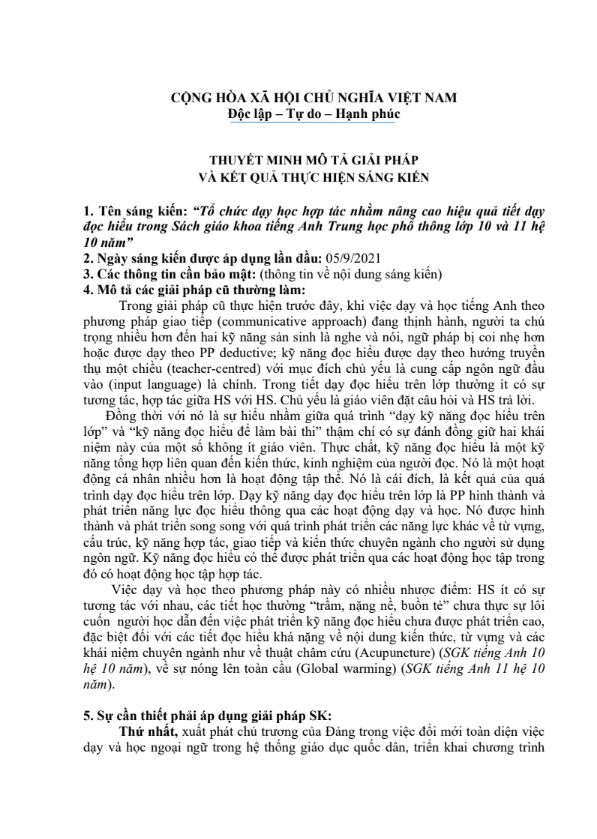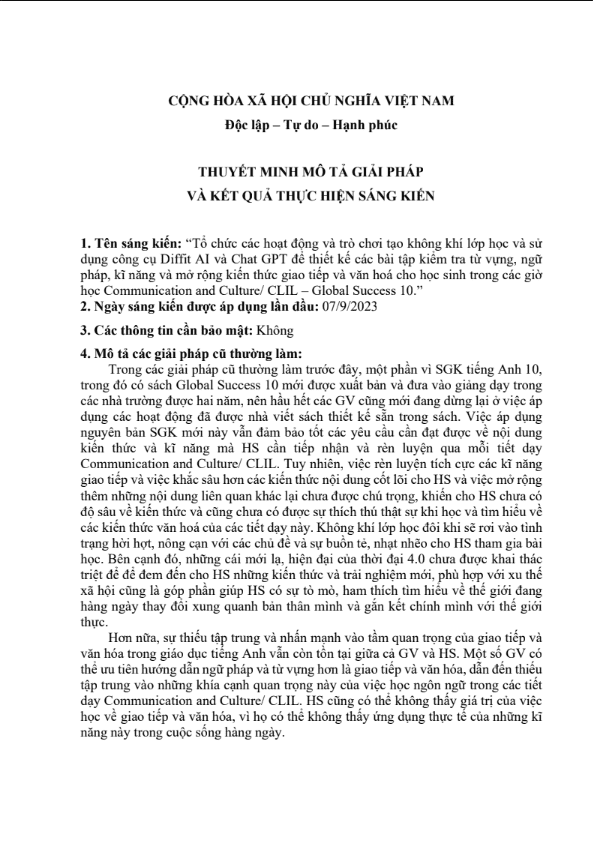SKKN Treatment of cross-cultural characteristics in the teaching of speaking skill to grade 12A2 students of English in Nam Dan 1 upper secondary school
- Mã tài liệu: MP0052 Copy
| Môn: | Tiếng anh |
| Lớp: | 12 |
| Bộ sách: | |
| Lượt xem: | 693 |
| Lượt tải: | 5 |
| Số trang: | 56 |
| Tác giả: | Hồ Thị Mỹ Hạnh |
| Trình độ chuyên môn: | Thạc sĩ giáo dục |
| Đơn vị công tác: | THPT Nam Đàn 1 |
| Năm viết: | 2021-2022 |
| Số trang: | 56 |
| Tác giả: | Hồ Thị Mỹ Hạnh |
| Trình độ chuyên môn: | Thạc sĩ giáo dục |
| Đơn vị công tác: | THPT Nam Đàn 1 |
| Năm viết: | 2021-2022 |
Sáng kiến kinh nghiệm “SKKN Treatment of cross-cultural characteristics in the teaching of speaking skill to grade 12A2 students of English in Nam Dan 1 upper secondary school” triển khai gồm các biện pháp nổi bật sau:
– Teachers and students’ sources in high school for enriching cross-cultural information
– Activities for improving cross-culture teaching methods in NDI high school
Mô tả sản phẩm
PART A . INTRODUCTION
1. Rationale
English, the most popular foreign language in Vietnam, has been taught from the early age (at the age of six or even younger) in most of schools throughout the country as a compulsory subject. Thus, many Vietnamese, especially the young people, can speak English; however; not many of them have intelligible cultural knowledge.
Personally, I think that cultural gaps are one of the most important keys lead us to success in communicating genuinely and understanding the real world outside the classroom. In order to use the language effectively, language teachers should realize that knowledge of the world’s language and culture is increasingly important. Language learners need to have mastery of not only the language itself but also the culture in which the language is used. Therefore, it is suggested that language teachers should focus on the integration of culture in language classroom, which serves as a tool for helping students understand and appreciate other cultures.
Nowadays, in teaching and learning English as a foreign language in Vietnam, speaking has received a great deal of attention. Nonetheless, English is learnt and taught in a non-native environment, students usually do not have close contact with native speakers of English and have little opportunity to discover how these speakers think, feel, and interact with others. That is the reason why they do not feel confident enough to converse with English teachers or native speakers and people in other countries where English is used mainly.
It proves everything clearly that culture and language can not be separated and the teaching and learning of a foreign language should always be a culture- based course. So as to improve student’s communicative competence, teacher should insert cross- cultural knowledge into the learning and teaching of speaking skills. From my teaching experience, cultural challenges in speaking-class have become a great source of inspiration for my thesis, which deals with the problem: “Treatment of cross-cultural characteristics in the teaching of speaking skill to grade 12A1 students of English.”. This study is, hence, to aim at treating crosscultural characteristics into teaching of speaking in English for the teacher and students at Nam Dan I high school.
The major aims of the study are as follows:
- To investigate the teachers’ and students’ attitudes towards the importance of cross- cultural knowledge to the learning of a foreign language.
- To find out the attitudes of teachers and students at Nam Dan 1 high school toward the importance of culture in learning speaking skills in English language teaching.
- To find out the effective ways of treatment cross-cultural characteristics into teaching of speaking skill in English.
2. Aims of the study
The major aims of the study are as follows:
- To investigate the teachers’ and students’ attitudes towards the importance of cross- cultural knowledge to the learning of a foreign language.
- To find out the attitudes of teachers and students at Nam Dan 1 high school toward the importance of culture in learning speaking skills in English language teaching.
- To find out the effective ways of treatment cross-cultural characteristics into teaching of speaking in English.
3. Scope of the study
To develop speaking skill and the communicative competence for students at Nam Dan I high school, teachers has made a lot of effort to motivate the students to participate in speaking class effectively. However, in the thesis, the researcher wants to find out the attitudes, as well as the cross-culture awareness in teaching and learning spoken English. The scope of this study is limited to the raising of students’ cross-cultural awareness through speaking only.
The subjects of the study are grade 12A2 students of English at Nam Dan I high school in Nghe An province. The suggestions and recommendations are all centered on a combination of task-based of activity- based syllabuses.
4. Methods of the study
Because the purpose of this study is to investigate the teachers` and students` perception of the role of cultural understanding in learning English, a questionnaire was used as the key instrument of data collection. Data were analysised quantitatively by means of descriptive statistics.
PART B. CONTENT
Chapter 1. Literature review
1.1. The importance of cross- cultural knowledge in foreign language learning
1.1.1. What is cross-culture?
Cross-culture can be seen as cultures in contact or cultures encounters. The term “cross-culture” usually refers to the meeting of two cultures or languages across the political boundaries of nation-states ( Claire Kramsch). They are predicated on the equivalence of one nation-one culture-one language. In foreign language, teaching a cross-cultural approach seeks ways to understand the other on the other side of the border by learning his or her national language. Cross-cultural communication does not only study cultural differences and their influences on the people’s behaviors but also see the similarities between them.
Effective cross-cultural communication is concerned with overcoming cultural differences across nationality, religion, borders, culture and behavior. Cross-cultural communication competency can only be truly achieved through cross cultural awareness training, language acquisition, foreign travel and cultural immersion.
Cross-cultural understanding refers to the basic ability of people to recognize, interpret and correctly react to people, incidences or situations that are open to misunderstanding due to cultural differences. It is said that cross-culture understanding is recognition of the ways in which two cultures resemble one another as well as the ways in which they differ.
Mastering cross-culture knowledge opens great vista for the teacher and provides a basis for better understanding of persons from other backgrounds, as well as supplying new insights into approaches to teaching a second language.
According to Meyer (cited in Eli Hinkel;1991:37), intercultural competence has been defined in foreign language learning as “the ability of a person to behave adequately in a flexible manner when confronted with actions, attitudes, and expectations of representatives of foreign cultures“.
1.1.2. The relationship between language and culture.
Culture, unlike language, does not consist of specific rules that apply to all people in one culture. Nevertheless, Culture and language have a close relationship. Many linguists have been discussed a question for a long time: how do the language and culture relate to each other? One of the most well known sources is Sapir-Whorf’s hypothesis (cited in Pinker 1994:59) state: “We cut nature up, organize it into concepts and as we do, largely because we are parties to an agreement to organize it in this way… an agreement that holds throughout our speech community and is codified in the patterns of our language. The agreement is, of course, an implicit and unstated one, but its terms are absolutely obligatory.” Pinker shows that Whorf did not do his research properly to prove his hypothesis. However, it cannot be denied that language and culture are profoundly connected, or rather, that language is inseparable from culture.
According to Claire Kramch (1998:3) “They give meaning to it through the medium they choose to communicate with one another, for example on the telephone or face to face, writing a letter or sending an e-mail message, reading
TÀI LIỆU LIÊN QUAN
- 7
- 105
- 1
- [product_views]
- 5
- 173
- 2
- [product_views]
- 4
- 165
- 3
- [product_views]
- 4
- 129
- 4
- [product_views]
100.000 ₫
- 6
- 434
- 5
- [product_views]
100.000 ₫
- 2
- 507
- 6
- [product_views]
100.000 ₫
- 9
- 546
- 7
- [product_views]
100.000 ₫
- 4
- 409
- 8
- [product_views]
100.000 ₫
- 2
- 595
- 9
- [product_views]
100.000 ₫
- 0
- 538
- 10
- [product_views]















